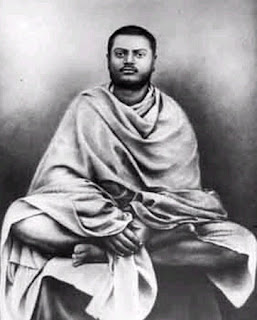Teachings of Swami Vivekananda - part 2
Swamiji provides us
with means of embarking on this journey. These means are not at all
theoretical. Even though both the means and ends are prescribed in countless
scriptures, they are least understood and it only takes a spiritual giant like
Swamiji to decipher it for the laymen and to make spiritual giants out of them.
A world teacher like Swamiji only teaches what he himself realizes and only a
person who has attained the summit like him can describe the summit as well as
the steps to climb it. As Sri Ramakrishna said, only a prince can traverse
throughout the palace. He can go up till the highest floor and come back to the
lowermost one. Only one who can go to the roof and come down can know that both
the roof and the stairs are made of the same material and can describe the
steps leading to the roof. The roof is the goal – the knowledge of advaita,
while the steps are the various states.
Swamiji therefore proclaimed that one
only moves from lower truth to higher truth and not from error to truth. Every
truth is relative till we have reached the absolute truth, only one being
better than the other, just as one state in the entire spectrum is higher than
the other, even though both are necessary. Unless we move from state to state
our learning is incomplete as we come to this world to learn, through
experience. When we have reached the highest state we have transcended the
pairs of opposites like happiness and misery, pleasure and pain. Till we have
reached the highest state,, such pairs of opposites will continue to dominate
our lives and one cannot be obtained without the other. For instance whatever
happiness that we derive from intellectual pursuits we cannot escape the associated
miseries as all sense pleasures inevitably result in miseries. All sensual
pleasures are transitory and therefore once they are exhausted misery continues
to haunt us. It is only the happiness of selflessness in the divine state that
results in less misery.
Gita also talks about the same thing in its definition
of the three types of Sukha or happiness – Sattvika, Rajasic and Tamasic. Sattvika
happiness is is initially troublesome but in the end provides bliss. It is
troublesome because it is difficult to embark into a endeavor that is devoid of
any sense pleasure or selfish gain, but in the end such an endevour gives one
maximum bliss. Rajasic happiness is blissful to begin with but in the end
creates miseries – as in pleasures derived from some intellectual pursuits,
sight seeing trips, business success and so on. Tamasic happiness is entirely
in sense pleasures of the lowest order like sexual gratification, eating,
sleeping, drinking and idleness. However he emphasizes and reemphasizes one
central, pivotal point in his teachings – Renunciation. Renunciation is the key
to realization. It is renunciation that is the core principle behind getting
into the divine state. However just externals will not suffice and one has to
have true detachment and dispassion as has been proclaimed loud and clear in
Gita. True renunciation consists of not altogether giving up actions, but
giving up all fruits of actions. Therefore Swamiji’s prescription was selfless
work as worship, to look every being as manifestation of God and serve him or
her to the best of one’s ability. In this way one is able to renounce all selfish
desires and fruits (of the good work) and is able to perform true “nishkama
karma”.
The reincarnation or
the karma is a necessary aid in this journey as through many lives one is able
to gain the knowledge to attain the highest state. The highest state, the
kingdom of heaven, cannot be obtained in one life. The lessons learnt in one
life are too inadequate for one to reach the greatest state. Only an avatar or
a divine incarnation is capable of going through all these myriad states in one
life and demonstrate them to the mankind.

Comments
Post a Comment
Here you can post your own opinions, no spam however will be tolerated and no hateful comments will be posted.